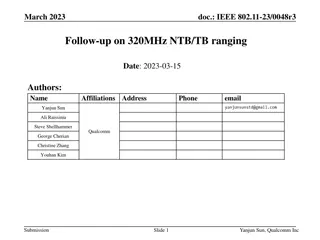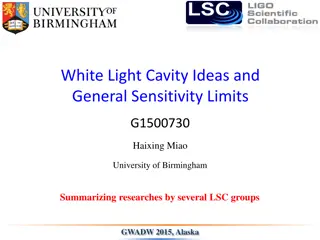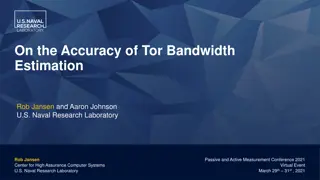Modeling and Generation of Realistic Network Activity Using Non-Negative Matrix Factorization
The GHOST project focuses on the challenges of modeling, analyzing, and generating patterns of network activity. By utilizing Non-Negative Matrix Factorization (NMF), realistic network activity patterns can be created and injected into live wireless networks. Understanding and predicting user behavi
4 views • 28 slides
IEEE 802.11-23/1288r0 Bandwidth Utilization Proposal
This proposal aims to improve bandwidth utilization in IEEE 802.11 networks by allowing devices to transmit on idle channels within the operating bandwidth. It addresses the inefficiencies caused by the current limitation where devices do not transmit on idle portions if the primary channel is busy.
2 views • 24 slides
Challenges and Requirements for Bandwidth Indication in IEEE 802.11
The document discusses challenges and requirements related to bandwidth indication in RTS/CTS frames with PPDU in 320 MHz, focusing on scenarios where bandwidth signaling may lead to misinterpretation by stations. It highlights the need for dynamic bandwidth and preamble puncturing information in RT
3 views • 21 slides
Network Compression Techniques: Overview and Practical Issues
Various network compression techniques such as network pruning, knowledge distillation, and parameter quantization are discussed in this content. The importance of pruning redundant weights and neurons in over-parameterized networks is highlighted. Practical issues like weight pruning and neuron pru
0 views • 37 slides
Proposal for Efficient Bandwidth Utilization in IEEE 802.11 Networks
This proposal aims to address the inefficient utilization of bandwidth in IEEE 802.11 networks by allowing stations to transmit on idle channels within their operating bandwidth. The document discusses the problem statement, high-level solution, relevant capabilities of transmitters and receivers, p
0 views • 15 slides
Network Slicing with OAI 5G CN Workshop Overview
Overview of Network Slicing with OAI 5G CN workshop focusing on the crucial role of network slicing in realizing the service-oriented 5G vision. This workshop covers topics like multiple logical networks creation on shared infrastructure, different types of network slices, preparation and instantiat
1 views • 6 slides
IEEE 802.11 Proposal for 320MHz Ranging Enhancement
This document discusses the proposal for enhancing IEEE 802.11 with support for 320MHz bandwidth ranging operations. It aims to improve ranging accuracy by expanding 802.11az frames and procedures to accommodate the increased bandwidth. The focus is on MAC-related changes, exploring different option
2 views • 26 slides
Understanding Performance Analysis of Digital Modulation Techniques
Explore the realm of digital modulation techniques such as ASK, FSK, PSK, QPSK, QAM, and more. Learn about bandwidth efficiency, baud rates, minimum bandwidth, and how to calculate them. Discover the importance of M-ary modulation and how it impacts data transmission rates and bandwidth requirements
4 views • 18 slides
Understanding Snort: An Open-Source Network Intrusion Detection System
Snort is an open-source Network Intrusion Detection System (NIDS) developed by Cisco, capable of analyzing network packets to identify suspicious activities. It can function as a packet sniffer, packet logger, or a full-fledged intrusion prevention system. By monitoring and matching network activity
0 views • 23 slides
Data Flows and Network Challenges in Particle Physics Infrastructure
This overview delves into the data flows and network challenges faced in particle physics infrastructure, focusing on the JUNO project. It discusses the process of data reception, storage, and replication across various data centers, highlighting the bidirectional nature of data flows. Additionally,
0 views • 24 slides
Improved Preamble Puncturing in IEEE 802.11be Standard
The document discusses enhancements in preamble puncturing for the IEEE 802.11be standard, focusing on improving channel utilization in various network scenarios within a 160MHz bandwidth. It introduces improvements for multi-user and single-user PPDU scenarios to maximize available bandwidth and en
0 views • 11 slides
Efficient Preamble Puncturing Support for IEEE 802.11 EHT Wide Bandwidth Transmission
The IEEE 802.11-20/0895r0 document addresses the introduction, issues, motivation, and support for preamble puncturing in EHT transmissions. It focuses on optimizing resource allocation while facilitating flexible preamble puncturing for OFDMA transmission in wide bandwidth scenarios, such as managi
0 views • 14 slides
Understanding EIGRP: A Comprehensive Overview
Enhanced Interior Gateway Routing Protocol (EIGRP) is a dynamic routing protocol providing various advantages to network administrators. It is a classless routing protocol supporting VLSM and is considered an Interior Gateway Protocol (IGP). EIGRP uses advanced distance vector routing and is known f
1 views • 5 slides
Advances in White Light Cavity for Sensitivity and Bandwidth Optimization
The research discusses innovative ideas for enhancing sensitivity and bandwidth limits in the context of white light cavity technologies. It explores methods such as external/internal squeezing and signal recycling to surpass existing Mizuno Limits, shedding light on crucial issues for future upgrad
0 views • 27 slides
Accelerator for VMware Backup Solutions
Today's challenges in backing up data from VMware environments include high data volume, small backup windows, slow traditional backups, network bandwidth utilization, and CPU overhead. NetBackup's Accelerator for VMware in version 7.6 addresses these challenges by using Changed Block Tracking (CBT)
0 views • 18 slides
Enhancing Memory Cache Efficiency with DRAM Compression Techniques
Explore the challenges faced by Moore's Law in relation to bandwidth limitations and the innovative solutions such as 3D-DRAM caches and compressed memory systems. Discover how compressing DRAM caches can improve bandwidth and capacity, leading to enhanced performance in memory-intensive application
0 views • 48 slides
Enhancing Support for Wider Bandwidth OFDMA in IEEE 802.11 Networks
The document discusses the implementation of Selective Spatial Transmission (SST) and Dynamic Subband Operation (DSO) to enable wider bandwidth OFDMA in IEEE 802.11be and 802.11bn standards. It covers enhancements for 80MHz, 160MHz, and 320MHz EHT DL and UL OFDMA transmissions, emphasizing the benef
0 views • 18 slides
IEEE 802.11-23/2141r0 Dynamic Subband Operation Discussion
Discussion on Dynamic Subband Operation in IEEE 802.11-23/2141r0 focusing on enabling flexible bandwidth allocation between APs and non-APs for improved resource utilization and system performance. The proposal aims to address bandwidth mismatches and enhance efficiency in channel access allocation
0 views • 15 slides
Bandwidth and Packet Type Detection Schemes for 40-50GHz Millimeter Wave Communication Systems
The document discusses bandwidth and packet type detection schemes for 40-50GHz millimeter wave communication systems in IEEE 802.11aj specifications. It proposes a preamble design for auto-detection of bandwidth and packet type to improve channel estimation and decoding efficiency. By utilizing dif
0 views • 27 slides
Congestion Control for High Bandwidth-Delay Product Networks
This presentation discusses the challenges faced by TCP in high bandwidth-delay product networks, highlighting issues such as oscillations and instability. It explores solutions like adjusting aggressiveness based on feedback delay, decoupling efficiency and fairness control, and introduces XCP as a
0 views • 23 slides
Optimized Content Transfer in Mesh Networks Using Bandwidth-Aware Chunking
This presentation by Gurdev Singh from Samsung addresses a technique for optimized content transfer in mesh networks by splitting content into file chunks based on the bandwidth of the channel. By considering the bandwidth or link quality of destination nodes, the content is divided so that lower ba
0 views • 20 slides
Understanding Network Performance Metrics in Telecommunications
This content delves into the realm of network performance measurement in telecommunications, focusing on metrics that impact service quality as perceived by customers. It covers a range of topics including network performance measures, system performance metrics, bandwidth, throughput, latency, erro
0 views • 14 slides
Enhancing Off-chip Bandwidth Utilization for Improved System Performance
Efficiently coordinating off-chip read/write bandwidth through the Bandwidth-aware LLC proposal yields a 12% performance improvement in an 8-core system across multiple workloads. This approach optimizes DRAM read latency, surpassing existing policies and filling performance gaps while confirming lo
1 views • 36 slides
Network and Security Assessment Findings at Tuxedo Union Free School District
National Business Technologies conducted a comprehensive assessment of the technology department at Tuxedo Union Free School District. The assessment covered methodologies, IT procedures and policies, technical infrastructure evaluations, and areas of concern including server infrastructure, interne
0 views • 10 slides
Time Distribution System R&D Update for Hyper-Kamiokande Experiment
In the February 2020 update, Stefano Russo from LPNHE Paris presented the progress on the time distribution system R&D for the Hyper-Kamiokande experiment. The focus is on implementing a bidirectional data exchange link with a large bandwidth capacity for synchronous, phase-deterministic protocol. T
0 views • 17 slides
Evolution of Italian Access Networks: A Comprehensive Overview
Explore the evolution of Italian access networks through various stages, from the Italian model of bitstream to detailed bandwidth management and QoS models. Discover the need to migrate to 10G kits in line with Nielsen's law of internet bandwidth. Delve into choices between ASR9K and ASR1K for mode
0 views • 10 slides
Understanding Bandwidth, Channel Capacity, and Noise in Communication Networks
Bandwidth is a crucial aspect of network capacity, describing the data transfer speed and carrying capacity of a channel. Channel capacity involves factors like data rate, bandwidth, noise, and error rate. Noise sources include thermal noise, impulse noise, and delay distortion, impacting signal qua
0 views • 5 slides
Accuracy of Tor Bandwidth Estimation Study
Study by Rob Jansen and Aaron Johnson from the U.S. Naval Research Laboratory reveals that Tor underestimates its network bandwidth capacity, with significant errors in estimation for high-capacity relays, exit relays, and relays with lower uptimes. The findings emphasize the importance of accurate
0 views • 16 slides
Cognitive Passive Estimation of Available Bandwidth in Overlapped IEEE 802.11 WiFi WLANs
Efficient bandwidth estimation is crucial for network management and QoS applications, with cognitive passive methods offering insights without additional traffic loads. This research explores the impact of control messaging overhead, network topology, channel usage, hidden/exposed terminals, and pa
0 views • 13 slides
DeltaINT: General In-band Network Telemetry with Low Bandwidth Overhead
This paper discusses DeltaINT, a novel framework for in-band network telemetry aimed at reducing bandwidth overhead while ensuring high generality and convergence. It addresses the limitations of existing methods by providing theoretical analysis on bandwidth mitigation guarantees and offering softw
0 views • 20 slides
Meeting Home Networking Bandwidth Needs with GEPOF Technology
Gigabit Ethernet over Polymer Optical Fiber (GEPOF) is a promising technology addressing the growing bandwidth requirements in home networking. Advances in FTTH technology enable high-speed connections for Smart Homes, supporting services like cloud computing, 4K video streaming, and Internet of Thi
0 views • 15 slides
Enhancing Tor Network Security and Performance with Tunable Path Selection
This presentation discusses the improvement of security and performance within the Tor network through tunable path selection. It covers Tor's design, proposed methods for bandwidth measurement, router selection algorithms, and the evaluation of different strategies to enhance the network's efficien
0 views • 29 slides
Intelligent DRAM Cache Strategies for Bandwidth Optimization
Efficiently managing DRAM caches is crucial due to increasing memory demands and bandwidth limitations. Strategies like using DRAM as a cache, architectural considerations for large DRAM caches, and understanding replacement policies are explored in this study to enhance memory bandwidth and capacit
0 views • 23 slides
Understanding Bandwidth and Dispersion in Fiber Optic Communication
This presentation provides a comprehensive overview of bandwidth and dispersion in fiber optic communication. It covers essential terminologies like microns, nanometers, millimeters, and dB, explaining concepts such as bandwidth capacity, dispersion cancellation, and modal bandwidth in multimode fib
0 views • 24 slides
Evolution of Communication Systems: From Bandwidth Division to Spread Spectrum
Third-generation communication systems utilize Pseudo-Noise (PN) codes to share bandwidth without interference, while first and second-generation systems divide bandwidth into smaller channels. PN codes are vectors with 1s and -1s, orthogonal to each other. Users transmit data using PN coding, combi
0 views • 14 slides
Enhancing Network Stability with Network Monitoring Systems
Network monitoring is crucial for efficient management and proactive issue detection in a network environment. Factors influencing an effective network system include choosing the best OEM, SLA agreements, and selecting a reliable System Integrator. Reactive monitoring can lead to financial losses a
0 views • 12 slides
Overview of UE RF Requirements for 35/45MHz Channel Bandwidth in 3GPP Meeting #97-e
The document discusses the introduction of 35/45MHz channel bandwidth in UE RF requirements for various bands. It covers equation-based requirements and limitations in UL configurations based on bandwidth allocation. The scope includes capturing content from the first round discussions and clarifyin
0 views • 16 slides
Understanding Interconnection Networks: Topology and Routing
Interconnection networks play a crucial role in determining the arrangement of channels and nodes within a network, similar to a road map guiding traffic flow. Topology overview defines the network structure, while abstract metrics help evaluate performance and cost. Latency and throughput are key f
0 views • 49 slides
Enhancing Bandwidth of Channel State Information (CSI) for Wireless Sensing Applications
This submission delves into the necessity of expanding the bandwidth of Channel State Information (CSI) in wireless environments to cater to the demands of time-sensitive wireless sensing applications. It explores the implications of high-bandwidth CSI on enhancing wireless channel understanding, ac
0 views • 12 slides
Enhancing Memory Bandwidth with Transparent Memory Compression
This research focuses on enabling transparent memory compression for commodity memory systems to address the growing demand for memory bandwidth. By implementing hardware compression without relying on operating system support, the goal is to optimize memory capacity and bandwidth efficiently. The a
0 views • 34 slides







































